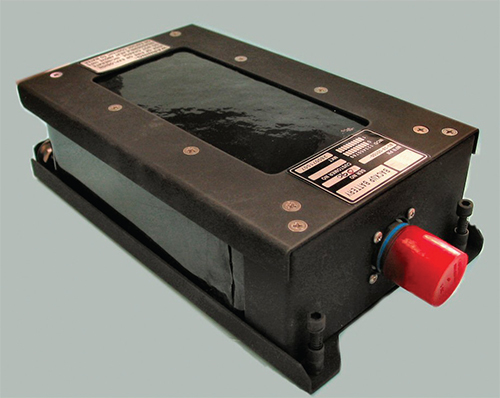More than 7000 unmanned aerial vehicles have been used in two Middle-East wars, and newer, smaller, and better ones are being designed and built every day.

General Atomics Aeronautical Systems, Inc. built the Altair UAV for NASA and National Oceanic and Atmospheric Administration for climate and environmental research programs.
Unmanned aerial vehicles (UAV) are relative newcomers to the modern battlefield. The first U.S. UAV, Pioneer, was used during the Gulf War. The most celebrated drone (an aircraft remotely controlled from a ground station), the Predator, flew its first spying mission over Bosnia. Later, two Hellfire laser-guided missiles used against ground targets augmented the Predator. During the Afghanistan and Iraq wars, the number of various UAVs used by the U.S. military rapidly grew to over seven thousand. Presently, UAV design is one of the most dynamic research and engineering fields, which requires new sources of power with greater energy density, smaller size, and improved reliability.
Some unmanned aircraft are equipped with propellers driven by internal combustion engines or electric motors. Others, such as the largest and most sophisticated UAV, the Global Hawk, have jet engines. Several futuristic, flapping-wing devices mimic the flight dynamics of bumblebees and flies. Most of these vehicles use batteries as a source of primary or back-up power.

Measuring approximately 8 m in length with a wingspan of 14.8 m, the Predator weighs approximately 500 kg. It can fly without refueling for 24 hours, and a single 101-hp engine that uses aircraft engine fuel powers it. Pushed by a propeller located in its rear, Predator can climb to about 7500 m and can reach the speed of 217 km/h. In addition to its 3-kW starter/alternator, the Predator has two 14 A-hr battery packs, each weighing 3.6 kg. The battery packs are intended to be used as back-up power in case the engine fails.
Several U.S. government agencies, universities, and private companies are busy developing extremely small, unmanned aircraft, many of which have electric motors powered by batteries or fuel cells. For example, the Dragon Eye developed by the U.S. Naval Research Laboratory can be carried in a backpack, quickly assembled, and launched with a bungee slingshot. The twin propellers of this 2.3 kg micro-aerial vehicle (MAV) are driven by electric motors powered by lithium batteries that last approximately one hour. The RQ-11B Raven B that replaced the Dragon Eye uses rechargeable batteries to power its propulsion and other systems. It can stay in the air for 1.5 hours.

The U.S. Army currently uses this battery pack in one of its unmanned aerial vehicles that flies reconnaissance missions in Iraq and Afghanistan. Built of 96 AA-size TLM batteries and rated at 32V/480W, it powers the aircraft’s emergency recovery system. Due to its light weight, approximately 2 kg, and considerably smaller size compared to the previously used batteries, this battery pack reduces overall system weight and requires less space inside the aircraft.
The much smaller Black Widow micro-spy has a wingspan of approximately 15 cm and weighs a little over 80 grams. It has a propeller mounted on the shaft of a tiny electric motor powered by lithium-ion batteries. This UAV can stay in the air for 30 min and, in spite of its small size, can reach speeds of 48 km/h.
Battery selection is one of the key factors for achieving desired vehicle operational parameters, reliability, storage time, activation time, maintenance, ease of testing, battery availability, and cost. As engineers make improvements to the existing UAVs and design new aircraft, they continuously look for lighter, more reliable, and less expensive batteries with higher energy density.
The Tadiran TLM Battery series of military grade high power primary Li Metal Oxide cells is one example of commercial-off-the-shelf (COTS) batteries suitable for many military applications. This includes UAV, missile guidance systems, torpedoes, bomb and artillery proximity fuses, and many others.
They are available in three cell sizes and comply with all required military environmental specifications, as well as UL and IEC safety standards. Some of the key features of the TLM series include a wide temperature range of -40°C to +85°C, low self-discharge, a storage life of 20 years, high reliability, and extremely light weight.
This advanced technology combines a carbon-based anode, a multi-metal oxide cathode, and organic electrolytes in a small, hermetically sealed can. Individual cells are assembled in battery packs to match the current and voltage requirements. Cells can be arranged in a shape that allows maximum use of available space in the UAV for the battery pack.
Examples of other battery technologies currently under development for UAV application are Lithium Polymer (LiPo) and Lithium Sulphide (LiSTM). For example, the Flight Power EVO 20 series of Lithium Polymer batteries has an average specific energy of 140 Wh/kg and a maximum current rating ranging from 66 to 148 A. Another manufacturer, Sion Power, developed a rechargeable LiSTM battery with an extremely high 350 Wh/kg specific energy.
A few UAVs use fuel cells and solar power as do other new technologies such as micro-generators, micro-turbines, and chemically powered systems that may replace batteries in the future. Nevertheless, battery technology is far from becoming obsolete: new designs introduced by battery manufacturers offer light, high capacity, and reliable sources of power.
For more information see:
Filed Under: Aerospace + defense, Energy management + harvesting, ELECTRONICS • ELECTRICAL





Tell Us What You Think!